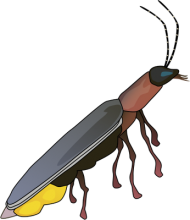Firefly populations are dwindling all over the world
Lightning bugs flash light to attract the opposite sex using a chemical called luciferase. There are over 136 species of lightning bugs, each with a distinctive rate of flashes per second. Male lightning bugs flash patterns of light to females who then signal in response from perches in or near the ground. When the male sees the female’s flash he continues to signal and moves closer until they finally find each other and mate. Lightning bugs are actually a type of beetle that is very beneficial in our ecosystem. The larvae stage of this beetle is a specialized predator that feeds on other insect larvae, earthworms, snails, and slugs. The tiny larval stage is dark gray with three pairs of legs and tiny spots on their underside that sometimes softly glow. Some adult lightning bug species are also predators, and other species don’t eat at all in the adult stage.Large swarms of lightning bugs are a less frequent occurrence in many areas. I can remember a midnight float down the Illinois River a few years ago when the river bank was alive with millions of flashing fireflies. This summer I saw lightning bugs, but not in large numbers. They are most prevalent away from city lights and in more open areas of vegetation. According to www.firefly.org firefly populations are dwindling all over the country, and the world.










